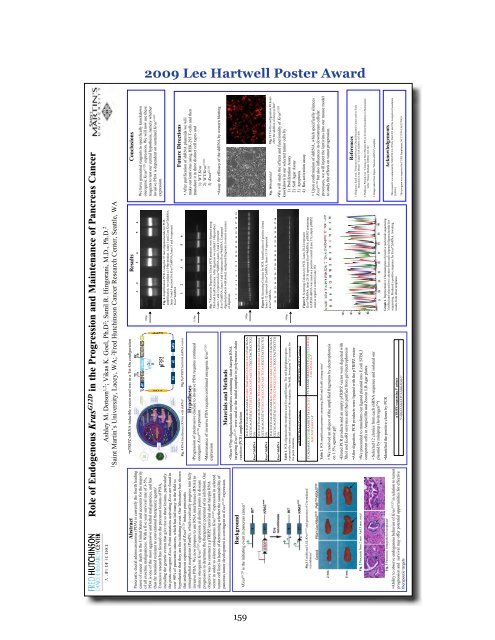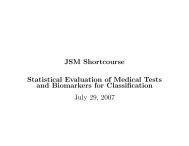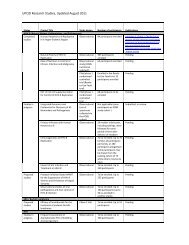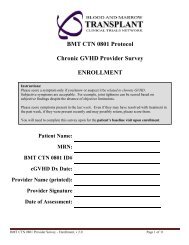Summer Undergraduate Research Program - Fred Hutchinson ...
Summer Undergraduate Research Program - Fred Hutchinson ...
Summer Undergraduate Research Program - Fred Hutchinson ...
Create successful ePaper yourself
Turn your PDF publications into a flip-book with our unique Google optimized e-Paper software.
Role of Endogenous Kras G12D in the Progression and Maintenance of of Pancreas Cancer<br />
Ashley M. Dotson 1,2 ; Vikas K. Goel, Ph.D 2 ; Sunil R. Hingorani, M.D., Ph.D. 2<br />
1 Saint Martin’s University, Lacey, WA; 2 <strong>Fred</strong> <strong>Hutchinson</strong> Cancer <strong>Research</strong> Center, Seattle, WA<br />
Conclusions<br />
Results<br />
pTRIPZ shRNA inducible vector used was in a Tet-On configuration<br />
1 2 3 4 5 6<br />
2009 Lee Hartwell Poster Award<br />
We have generated reagents to specifically knockdown<br />
oncogenic KrasG12D expression. We will now use these<br />
reagents to test our central hypothesis, namely whether<br />
invasive PDA is dependent on sustained KrasG12D expression.<br />
134bp<br />
Fig. 6 Amplification PCR. Using the 97 mer oligonucleotide for PCR<br />
amplification, we yielded a 134bp product. Lanes 1 and 2 are Kras*2shRNA;<br />
lanes 3 and 4 account for Kras*3shRNA; lanes 5 and 6 represent<br />
Kras*4shRNA<br />
Fig. 5 pTRIPZ lentiviral shRNA vector<br />
Fig. 4 RNA Interference (RNAi) with shRNA<br />
Future Directions<br />
After purification of shRNA plasmids we will<br />
make our lentivirus using HEK-293 T-cells and then<br />
transduce it in three distinct cell types and<br />
1) WT Kras<br />
2) WT/KrasG12D 3) KrasG12D Hypotheses<br />
Progression of preinvasive disease to invasive PDA requires continued<br />
oncogenic KrasG12D expression<br />
Maintenance of invasive PDA requires continued oncogenic Kras G12D<br />
expression<br />
Abstract<br />
Pancreatic ductal adenocarcinoma (PDA) is currently the fourth leading<br />
cause of cancer death in the United States and accounts for the majority<br />
of all exocrine malignancies. With a five year survival rate of 3-5%,<br />
PDA is one of the most aggressive and lethal malignancies, and has<br />
thus far remained resistant to conventional therapeutic agents1 .<br />
Extensive research has focused on the precursor lesions of PDA,<br />
including the genetic events that give rise to these lesions, particularly<br />
the proto-oncogene Kras. Point mutations activating Kras are found in<br />
over 90% of pancreatic cancers, which has led many in the field to<br />
hypothesize that they are the initiating event. Our laboratory has shown<br />
that endogenous expression of KrasG12D induces pancreatic<br />
intraepithelial neoplasias (PanIN), which eventually progress into fully<br />
invasive PDA. 1 We now propose to use RNA interference (RNAi) to<br />
silence oncogenic KrasG12D expression at distinct points in disease<br />
progression to determine the therapeutic potential of its inhibition. Our<br />
objective was to construct a pTRIPZ lentiviral short hairpin RNA<br />
vector in order to silence endogenous KrasG12D expression in selected<br />
tumor cell lines in hopes of determining whether the sustainability of<br />
pancreas tumor development is contingent on KrasG12D expression.<br />
1 2 3 4 5 6<br />
Fig. 4 RNA Interference (RNAi) with shRNA3 Fig. 5 pTRIPZ lentiviral shRNA vector<br />
114bp<br />
Assay the efficacy of the shRNA by western blotting<br />
Fig. 7 Restriction Digestion. Eluted PCR products were digested using<br />
XhoI and EcoRI enzymes. After digestion we yielded 114bp product.<br />
Lanes 1 and 2 represent Kras*2shRNA; lanes 3 and 4 represent<br />
Kras*3shRNA; lanes 5 and 6 represent Kras*4shRNA. Compared<br />
digested products with eluted, undigested fragments to ensure accuracy<br />
of digestion.<br />
1 2 3 4 5 6 7 8 9 10 11 12 13 14 15 16 17 18 19<br />
Materials and Methods<br />
Three 97bp oligonucleotide templates containing short hairpin RNA<br />
targeting KrasG12D were used as the initial template in polymerase chain<br />
reaction (PCR) amplification<br />
TGCTGTTGACAGTGAGCGAGAGCTGaTGGCGTAGGCAAGATAGTGAA<br />
GCCACAGATGTATCTTGCCTACGCCATCAGCTCCTGCCTACTGCCTCG<br />
Kras*2shRNA GA<br />
TGCTGTTGACAGTGAGCGCTGGAGCTGaTGGCGTAGGCAATAGTGAA<br />
GCCACAGATGTATTGCCTACGCCATCAGCTCCAATGCCTACTGCCTCG<br />
Kras*3shRNA GA<br />
TGCTGTTGACAGTGAGCGACTGaTGGCGTAGGCAAGAGCGTAGTGAA<br />
Background<br />
Kras G12D is the initiating event in pancreas cancer 1<br />
340bp<br />
159<br />
We will study the effects and functionality of KrasG12D Fig. 10 Brightfield3 Fig. 11 Tet-On configuration 48 hours<br />
after the addition of doxycycline<br />
knockdown in our selected tumor cells by<br />
1) Proliferation Assay<br />
2) Soft Agar Assay<br />
3) Apoptosis<br />
4) Ras activation assay<br />
3<br />
Figure 8. Screening Colonies by PCR. Identification of positive clones.<br />
lanes 1-12 represent Kras*2shRNA; lanes 13-19 represent<br />
Kras*3shRNA.<br />
20 21 22 23 24 25 26 27 28 29 30 31 32 33 34 35 36 37 38<br />
GCCACAGATGTACGCTCTTGCCTACGCCATCAGCTGCCTACTGCCTCG<br />
GA<br />
Kras*4shRNA<br />
340bp<br />
Table 1. PCR oligonucleotide templates used for amplification. The red highlighted regions<br />
represent the sense and antisense portions of the sequence. The bold, lowercase “a” accounts for<br />
the point mutation.<br />
miR30PCRxhol (5’primer) miR30PCREcoRIF (3’primer)<br />
Figure 9. Screening Colonies by PCR. Lanes 20-24 represent<br />
Kras*3shRNA; lanes 25-36 represent Kras*4shRNA; pTRIPZ containing<br />
GAPDH shRNA was used as a positive control (Lane 37); empty pTRIPZ<br />
used as negative control (Lane 38)<br />
5’CTAAAGTAGCCCCTTGAATTCCGAGG<br />
CAGTAGGCA-3’<br />
5’CAGAAGGCTCGAGAAGGTATATGCTGTT<br />
GACAGTGAGCG-3’<br />
Fig.1 Conditional LSL-KrasG12D and generation of Cre-mediated<br />
recombinase1 Upon confirmation of shRNA, which specifically silences<br />
KrasG12D but also influences its downstream cellular<br />
processes, we will inject the lentivirus into our mouse model<br />
to study the effects on tumor progression.<br />
Table 2. PCR amplification primers containing XhoI and EcoRI cloning sites 2<br />
We resolved an aliquot of the amplified fragments by electrophoresis<br />
on 1.5% agarose gel<br />
Eluted PCR products and an empty pTRIPZ vector were digested with<br />
XhoI and EcoRI enzymes and then purified from gel electrophoresis<br />
References<br />
1. Hingorani, Sunil et al. "Preinvasive and Invasive Ductal Pancreatic Cancer and its Early<br />
Detection in the Mouse." Cancer Cell 4(2003): 437-450.<br />
After digestion, PCR products were ligated with the pTRIPZ vector<br />
We proceeded to transform our ligated plasmid into E.coli STBL3<br />
competent cells in Ampicillin and Zeocin LB Agar plates<br />
Fig. 2 Pancreata from 2 mos. And 5 mos. mice 1<br />
2. Paddison, Patrick et al. "Cloning of Short Hairpin RNAs for Gene Knockdown in Mammalian<br />
Cells." Nature Methods 1(2004): 163-167.<br />
3. Images taken from Sigma “Mission shRNA” pamphlet<br />
Selected 12 clonies from each shRNA sequence and isolated our<br />
plasmid by miniprep (Invitrogen TM )<br />
Acknowledgements<br />
This research was supported by NIH (P30 CA15704), PanCAN and The Lustgarten Foundation.<br />
[S.R.H.]<br />
Graph 1. Representative Chromatogram of positive nucleotide sequencing.<br />
Verified and selected two colonies from each targeted oligonucleotide for<br />
sequencing. Produced a positive sequence for Kras*2shRNA. Awaiting<br />
results from other templates.<br />
Identified the positive clones by PCR<br />
Fig. 3 Pancreatic intraepithelial neoplasias 1<br />
This program was supported by CURE Supplement, NCI 2 P30 CA01570435<br />
pTRIPZ sequencing 5’ primer<br />
5’-GGAAAGAATCAAGGAGG-3’<br />
Ability to observe endogenous behavior of KrasG12D in relation to tumor<br />
progression and survival may offer potential opportunities for effective<br />
therapeutic targets
















